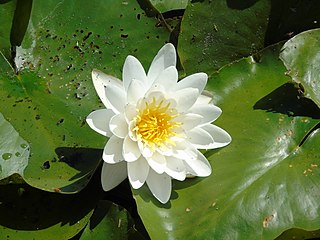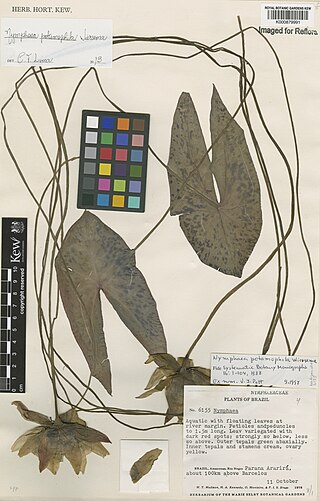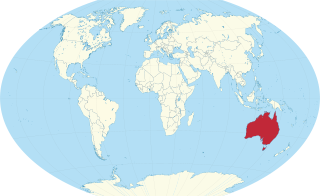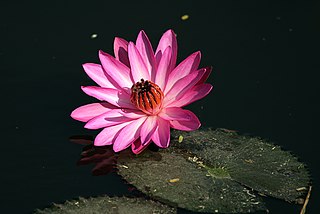
Nymphaea is a genus of hardy and tender aquatic plants in the family Nymphaeaceae. The genus has a cosmopolitan distribution. Many species are cultivated as ornamental plants, and many cultivars have been bred. Some taxa occur as introduced species where they are not native, and some are weeds. Plants of the genus are known commonly as water lilies, or waterlilies in the United Kingdom. The genus name is from the Greek νυμφαία, nymphaia and the Latin nymphaea, which means "water lily" and were inspired by the nymphs of Greek and Latin mythology.

Nymphaea leibergii, also known as the dwarf waterlily and Leiberg's waterlily, is a perennial emergent aquatic plant belonging to the genus Nymphaea. It can be found across northern North America in ponds and slow moving streams. Populations of this plant are infrequent throughout its range, and it is protected as a state threatened plant in Maine, Michigan, and Minnesota.

Nymphaea thermarum, also known as Pygmy Rwandan water lily, is a species of water lily that is endemic to Rwanda. Once thought to be extinct in the wild, all wild plants were believed to be lost due to destruction of its native habitat, but it was thought to be saved from extinction when it was grown from seed at the Royal Botanic Gardens, Kew in 2009. A previously-unknown wild population was discovered in 2023.

Nymphaea gigantea, commonly known as the giant waterlily or blue waterlily, is a perennial, herbaceous plant in the family Nymphaeaceae which is native to parts of northern and eastern Australia, and it has been widely cultivated elsewhere. It is an aquatic plant whose natural habitat is permanent and semi-permanent still water bodies

Nymphaea potamophila is a species of waterlily native to the region spanning from Venezuela to northern Brazil. Additionally, it has been reported to occur in Colombia.
Nymphaea belophylla is a species of waterlily native to Bolivia, Brazil and Venezuela.

Nymphaea caatingae is a species of waterlily endemic to Northeast Brazil.
Nymphaea conardii is a species of waterlily native to the region spanning from Southern Mexico to tropical South America.
Nymphaea lingulata is a species of waterlily native to Bolivia, Brazil, and Paraguay.
Nymphaea novogranatensis is a species of waterlily native to Colombia, Mexico, and Venezuela.

Nymphaea vaporalis is a species of waterlily endemic to Queensland, Australia.

Nymphaea × daubenyana is a species of waterlily endemic to Chad, but has been introduced to Florida, USA. It is a natural hybrid of Nymphaea micrantha and Nymphaea nouchali var. caerulea.

Nymphaea georginae is a species of waterlily native to the Northern Territory, and the state of Queensland, Australia.

Nymphaea gracilis is a species of waterlily endemic to Mexico. It is the only species of its genus which is endemic to Mexico.

Nymphaea jacobsii is a species of waterlily endemic to Queensland, Australia.

Nymphaea kakaduensis is a species of waterlily endemic to the Northern Territory, Australia.

Nymphaea loriana is a species of waterlily endemic to Manitoba, and Saskatchewan, Canada.

Nymphaea manipurensis is a species of waterlily endemic to Assam, India.

Nymphaea rubra is a species of waterlily native to the region spanning from Sri Lanka and northeastern India to western and central Malesia. Additionally, it has been introduced to regions such as Southeast China, Cuba, Guyana, Hungary, and Suriname.

Nymphaea subg. Brachyceras is a subgenus of the genus Nymphaea.













